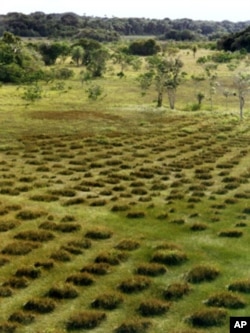The Amazon region of South America, the largest tropical rainforest and river basin on Earth, is disappearing at a rate of around 800,000 hectares a year, but a new study finds one possible strategy for reversing this trend in ancient Amazonian farming methods.
Analysis of a 1,000-year-old ecological record in the Amazon provides a rare glimpse at early farming practices before European explorers began arriving in the Americas more than 500 years ago.
The study, published in Proceedings of the National Academy of Sciences, finds the ancient farming methods could slow the destruction of the Amazon rainforest.
The rapid expansion of agriculture and cattle ranching, road and dam construction, and illegal logging are the biggest drivers of this massive deforestation.
Lead author Jose Iriarte, a paleoethnobotonist at the University of Exeter in England, focused on a coastal wetland savanna in present-day French Guyana, on South America’s northeastern coast, where ancient farm beds and canals remain, unaltered, on the landscape. In pre-colonial history, Iriarte says, this was a period when farmers “reclaimed these seasonally flooded savannas into raised-field agricultural landscapes.”
A sediment core from the site provided the team with an unusually intact archive of how farmers farmed these fields. It shows pollen, plant species and charcoal before and after the European colonization in the late 15th and 16th centuries.
Geographer Mitchell Power, curator of the Natural History Museum at the University of Utah, studied charcoal in the core. He says while evidence shows that naturally-occurring fires began decreasing globally around 1500 - a period of documented climate cooling - that’s not what they saw in the Amazonian record.
“When we went to the French Guyana site to try to understand the record, the most surprising thing to me was that it was the opposite trend. Fire was very low and then after 1500, fire increased," he said. "That was contrary to what 90 percent of the rest of the records around the world are telling us.”
Iriarte says the farmers understood how fire could harm the land and agricultural production.
“We know that fire results in the loss of crucial nutrients for crops, [and that] fallows without fires are most effective in restoring soil organic matter and preserving soil structure," he said. "So we interpreted that they were limiting fires because it was better to grow crops in these raised field systems.”
Iriarte says use of this fire-free method by the pre-Columbian farmers helped them transform the seasonally-flooded savanna into productive cropland.
“Raised fields provided better drainage, soil aeration, and also moisture retention during the dry season. These raised fields were constructed mainly with the muck from these seasonally flooded savannahs," he said. "So they are really fertile and they can be recycled every season.”
Mitchell Power says this labor-intensive approach ended abruptly when as much as 95 percent of the indigenous population died from a variety of Old-World diseases brought by the European settlers.
“Once the Columbian encounter happens we don’t see that type of agriculture any more," he said. "We start to see increased burning and a shift toward dry land farming. So people were then clearing forests and making their raised beds in the forests. And what we think is happening was a huge demographic collapse in this region.”
Slash-and-burn agriculture - introduced to the Amazon not by the native farmers but by European colonizers - remains today a major threat to the rainforest. Experts say if such practices continue at the current rate, more than half of the Amazon’s tropical rainforest could be gone by 2030.
Iriarte says pre-Columbian farming methods offer a tried-and-true alternative.
“It has the capability to help curb carbon emissions and at the same time provide food security for the more vulnerable and poorest rural populations of rural Amazonia,” he said.
The authors say bringing back these labor-intensive but productive farming systems to serve today’s - and tomorrow’s - food needs will require extensive farmer re-training - and the political will of the region’s governments. And they believe that if the Amazon’s current stewards can reclaim the wisdom of their ancestors, the damage to the world’s greatest rainforest can be slowed.











